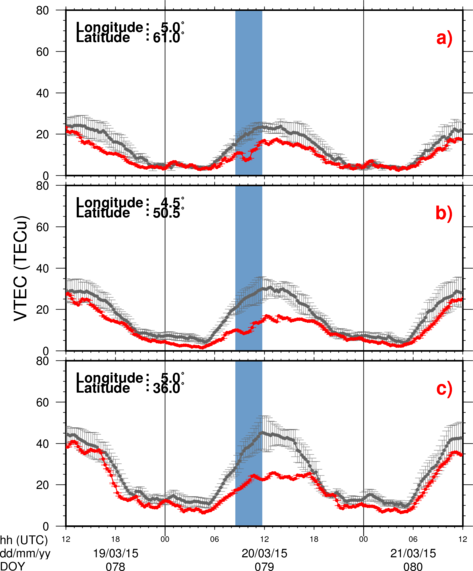Ionosphere
Ionospheric impacts of the solar eclipse measured by satellites

The ionosphere is a layer of charged particles in the Earth's atmosphere,
located from about 60km to 1000km above the Earth's surface.
As the Sun's radiation ionizes this layer, the ionosphere is a plasma of ions and free electrons (hence its name). These electrons perturb the propagation of communication signals by inducing a so-called ionospheric delay. The number of electrons is represented by the Vertical Total Electron Content (VTEC) and directly related to the signal propagation delay due to the ionosphere.
The figure shows the time evolution of the VTEC (the red line) in the northern part of Europe (top), above Brussels (middle), and in the southern part of Europe (bottom). This figure also shows (in grey) the normal ionospheric behavior expected based on the median VTEC from the 15 previous days.
ROB is monitoring the ionosphere in near real-time over Europe which will permit to follow the ionospheric activity during the eclipse. Normally, if the Sun's radiation (extreme ultraviolet) decreases dramatically during the eclipse, this should lead to a depletion of the electrons in the atmosphere due to less ionization, i.e. the red curve should be slightly below the grey expectation. And indeed, a decrease is detected, irrespective if clouds are present at the location where the measurements are done.
As the Sun's radiation ionizes this layer, the ionosphere is a plasma of ions and free electrons (hence its name). These electrons perturb the propagation of communication signals by inducing a so-called ionospheric delay. The number of electrons is represented by the Vertical Total Electron Content (VTEC) and directly related to the signal propagation delay due to the ionosphere.
The figure shows the time evolution of the VTEC (the red line) in the northern part of Europe (top), above Brussels (middle), and in the southern part of Europe (bottom). This figure also shows (in grey) the normal ionospheric behavior expected based on the median VTEC from the 15 previous days.
ROB is monitoring the ionosphere in near real-time over Europe which will permit to follow the ionospheric activity during the eclipse. Normally, if the Sun's radiation (extreme ultraviolet) decreases dramatically during the eclipse, this should lead to a depletion of the electrons in the atmosphere due to less ionization, i.e. the red curve should be slightly below the grey expectation. And indeed, a decrease is detected, irrespective if clouds are present at the location where the measurements are done.



